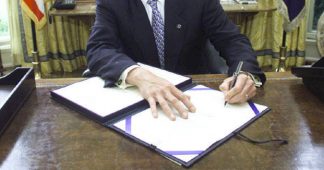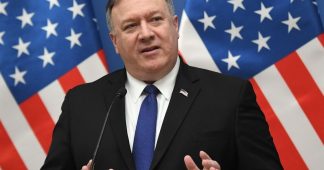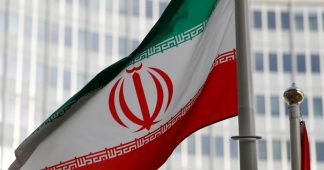Project for the New American Century
The Project for the New American Century (PNAC) was a neoconservative[1][2][3] think tank based in Washington, D.C. that focused on United States foreign policy. It was established as a non-profit educational organization in 1997, and founded by William Kristol and Robert Kagan.[4][5] PNAC’s stated goal was “to promote American global leadership.”[6] The organization stated that “American leadership is good both for America and for the world,” and sought to build support for “a Reaganite policy of military strength and moral clarity.”[7]
Of the twenty-five people who signed PNAC’s founding statement of principles, ten went on to serve in the administration of U.S. President George W. Bush, including Dick Cheney, Donald Rumsfeld, and Paul Wolfowitz.[8][9][10][11] Observers such as Irwin Stelzer and Dave Grondin have suggested that the PNAC played a key role in shaping the foreign policy of the Bush Administration, particularly in building support for the Iraq War.[12][13][14][15] Academics such as Inderjeet Parmar, Phillip Hammond, and Donald E. Abelson have said PNAC’s influence on the George W. Bush administration has been exaggerated.[16][17][18]
The Project for the New American Century ceased to function in 2006;[19] it was replaced by a new think-tank named the Foreign Policy Initiative, co-founded by Kristol and Kagan in 2009. The Foreign Policy Initiative was dissolved in 2017.
Origins and operation
The Project for the New American Century developed from Kristol and Kagan’s belief that the Republican Party lacked a “compelling vision for American foreign policy,” which would allow Republican leaders to effectively criticize President Bill Clinton’s foreign policy record.[19]
During the summer of 1996, Kristol and Kagan co-authored an article in Foreign Affairs titled “Toward a Neo-Reaganite Foreign Policy” – referring to the foreign policy of President Ronald Reagan. In the article, they argued that American conservatives were “adrift” in the area of foreign policy, advocated a “more elevated vision of America’s international role,” and suggested that the United States’ should adopt a stance of “benevolent global hegemony.”[20] In June 1997, Kristol and Kagan founded the PNAC in order to advance the goals they had first laid out in Foreign Affairs, echoing the article’s statements and goals in PNAC’s founding Statement of Principles.[19]
According to Maria Ryan, the individuals who signed the PNAC’s statements and letters were not employees or members of the group, and “supporters of PNAC’s initiatives differed from case to case.”[19] While its permanent staff was relatively small, the organization was “especially well connected,” with some of its statements and letters attracting the support of prominent conservatives and neoconservatives.[9][19]
In this regard, Stuart Elden has stated that “The influence that PNAC had was astonishing,” and noted that
“The number of figures associated with PNAC that had been members of the Reagan or the first Bush administration and the number that would take up office with the administration of the second President Bush demonstrate that it is not merely a question of employees and budgets.[21]”
Statement of Principles
PNAC’s first public act was to release a “Statement of Principles” on June 3, 1997. The statement had 25 signers, including project members and outside supporters (see Signatories to Statement of Principles). It described the United States as the “world’s pre-eminent power,” and said that the nation faced a challenge to “shape a new century favorable to American principles and interests.” In order to achieve this goal, the statement’s signers called for significant increases in defense spending, and for the promotion of “political and economic freedom abroad.” It said the United States should strengthen ties with its democratic allies, “challenge regimes hostile to our interests and values,” and preserve and extend “an international order friendly to our security, our prosperity, and our principles.” Calling for a “Reaganite” policy of “military strength and moral clarity,” it concluded that PNAC’s principles were necessary “if the United States is to build on the successes of this past century and to ensure our security and our greatness in the next.”[5]
In September 2000 PNAC released “Rebuilding America’s Defenses” a report that promotes “the belief that America should seek to preserve and extend its position of global leadership by maintaining the preeminence of U.S. military forces.” The report also states, “advanced forms of biological warfare that can “target” specific genotypes may transform biological warfare from the realm of terror to a politically useful tool.”[22][23][24]
Calls for regime change in Iraq
In 1998, Kristol and Kagan advocated regime change in Iraq throughout the Iraq disarmament process through articles that were published in the New York Times.[25][26] Following perceived Iraqi unwillingness to co-operate with UN weapons inspections, core members of the PNAC including Richard Perle, Paul Wolfowitz, R. James Woolsey, Elliot Abrams, Donald Rumsfeld, Robert Zoellick, and John Bolton were among the signatories of an open letter initiated by the PNAC to President Bill Clinton calling for the removal of Saddam Hussein.[19][27] Portraying Saddam Hussein as a threat to the United States, its Middle East allies, and oil resources in the region, and emphasizing the potential danger of any weapons of mass destruction under Iraq’s control, the letter asserted that the United States could “no longer depend on our partners in the Gulf War to continue to uphold the sanctions or to punish Saddam when he blocks or evades UN inspections.” Stating that American policy “cannot continue to be crippled by a misguided insistence on unanimity in the UN Security Council,” the letter’s signatories asserted that “the U.S. has the authority under existing UN resolutions to take the necessary steps, including military steps, to protect our vital interests in the Gulf.”[28] Believing that UN sanctions against Iraq would be an ineffective means of disarming Iraq, PNAC members also wrote a letter to Republican members of the U.S. Congress Newt Gingrich and Trent Lott,[29] urging Congress to act, and supported the Iraq Liberation Act of 1998 (H.R.4655)[30][31] which President Clinton signed into law in October 1998.
In February 1998, some of the same individuals who had signed the PNAC letter in January also signed a similar letter to Clinton, from the bipartisan Committee for Peace and Security in the Gulf.[27][32]
In January 1999, the PNAC circulated a memo that criticized the December 1998 bombing of Iraq in Operation Desert Fox as ineffective. The memo questioned the viability of Iraqi democratic opposition, which the U.S. was supporting through the Iraq Liberation Act, and referred to any “containment” policy as an illusion.[33]
Shortly after the September 11, 2001 attacks, the PNAC sent a letter to President George W. Bush, specifically advocating regime change through “a determined effort to remove Saddam Hussein from power in Iraq.” The letter suggested that “any strategy aiming at the eradication of terrorism and its sponsors must include a determined effort to remove Saddam Hussein from power in Iraq,” even if no evidence surfaced linking Iraq to the September 11 attacks. The letter warned that allowing Hussein to remain in power would be “an early and perhaps decisive surrender in the war on international terrorism.”[34] From 2001 through the invasion of Iraq, the PNAC and many of its members voiced active support for military action against Iraq, and asserted leaving Saddam Hussein in power would be “surrender to terrorism.”[35][36][37][38][39]
Some have regarded the PNAC’s January 16, 1998 letter to President Clinton urging “the removal of Saddam Hussein’s regime from power,”[28][40] and the involvement of multiple PNAC members in the Bush Administration[10][11] as evidence that the PNAC had a significant influence on the Bush Administration’s decision to invade Iraq, or even argued that the invasion was a foregone conclusion.[14][41][42][43][44] Writing in Der Spiegel in 2003, for example, Jochen Bölsche specifically referred to PNAC when he claimed that “ultra-rightwing US think-tanks” had been “drawing up plans for an era of American global domination, for the emasculation of the UN, and an aggressive war against Iraq” in “broad daylight” since 1998.[45] Similarly, BBC journalist Paul Reynolds portrayed PNAC’s activities and goals as key to understanding the foreign policy of the George W. Bush administration after September 11, 2001, suggesting that Bush’s “dominant” foreign policy was at least partly inspired by the PNAC’s ideas.[41]
Some[who?] political scientists, historians, and other academics have been critical of many of these claims. Donald E. Abelson has written that scholars studying “PNAC’s ascendancy” in the political arena “cannot possibly overlook the fact” that several of the signatories to PNAC’s Statement of Purposes “received high level positions in the Bush administration,” but that acknowledging these facts “is a far cry from making the claim that the institute was the architect of Bush’s foreign policy.”[16][46][47]
Rebuilding America’s Defenses
One of the PNAC’s most influential publications was a 90-page report titled Rebuilding America’s Defenses: Strategies, Forces, and Resources For a New Century. Citing the PNAC’s 1997 Statement of Principles, Rebuilding America’s Defenses asserted that the United States should “seek to preserve and extend its position of global leadership” by “maintaining the preeminence of U.S. military forces.”[48] The report’s primary author was Giselle Donnelly, then going by the first name Thomas. Donald Kagan and Gary Schmitt are credited as project chairmen. It also lists the names of 27 other participants who contributed papers or attended meetings related to the production of the report, six of whom subsequently assumed key defense and foreign policy positions in the Bush administration.[49][50] It suggested that the preceding decade had been a time of peace and stability, which had provided “the geopolitical framework for widespread economic growth” and “the spread of American principles of liberty and democracy.” The report warned that “no moment in international politics can be frozen in time; even a global Pax Americana will not preserve itself.
According to the report, current levels of defense spending were insufficient, forcing policymakers “to try ineffectually to “manage” increasingly large risks.” The result, it suggested, was a form “paying for today’s needs by shortchanging tomorrow’s; withdrawing from constabulary missions to retain strength for large-scale wars; “choosing” between presence in Europe or presence in Asia; and so on.” All of these, the report asserted, were “bad choices” and “false economies,” which did little to promote long-term American interests. “The true cost of not meeting our defense requirements,” the report argued, “will be a lessened capacity for American global leadership and, ultimately, the loss of a global security order that is uniquely friendly to American principles and prosperity.”[48]
Rebuilding America’s Defenses recommended establishing four core missions for US military forces: the defense of the “American homeland,” the fighting and winning of “multiple, simultaneous major theatre wars,” the performance of “‘constabular’ duties associated with shaping the security environment” in key regions, and the transformation of US forces “to exploit the ‘revolution in military affairs.'” Its specific recommendations included the maintenance of US nuclear superiority, an increase of the active personnel strength of the military from 1.4 to 1.6 million people, the redeployment of US forces to Southeast Europe and Asia, and the “selective” modernization of US forces. The report advocated the cancellation of “roadblock” programs such as the Joint Strike Fighter (which it argued would absorb “exorbitant” amounts of Pentagon funding while providing limited gains), but favored the development of “global missile defenses,” and the control of “space and cyberspace,” including the creation of a new military service with the mission of “space control.” To help achieve these aims, Rebuilding America’s Defenses advocated a gradual increase in military and defense spending “to a minimum level of 3.5 to 3.8 percent of gross domestic product, adding $15 billion to $20 billion to total defense spending annually.[48] That amount is at least 17% to 19% or $355 billion to $386 billion of the US federal tax revenue in 2000 with annual increases of 4%-6%.[51]
Critics
Rebuilding America’s Defenses
Written before the September 11 attacks, and during political debates of the War in Iraq, a section of Rebuilding America’s Defenses entitled “Creating Tomorrow’s Dominant Force” became the subject of considerable controversy: “Further, the process of transformation, even if it brings revolutionary change, is likely to be a long one, absent some catastrophic and catalyzing event – like a new Pearl Harbor.”[48] Journalist John Pilger pointed to this passage when he argued that the Bush administration had used the events of September 11 as an opportunity to capitalize on long-desired plans.[52]
Some critics went further, asserting that Rebuilding America’s Defenses should be viewed as a program for global American hegemony. Writing in Der Spiegel in 2003, Jochen Bölsche claimed that Rebuilding America’s Defenses “had been developed by PNAC for Rumsfeld, Cheney, Wolfowitz and Libby,” and was “devoted to matters of ‘maintaining US pre-eminence, thwarting rival powers and shaping the global security system according to US interests.'”[45][53] British MP Michael Meacher made similar allegations in 2003, stating that the document was “a blueprint for the creation of a global Pax Americana,” which had been “drawn up for” key members of the Bush administration.[54] Academic Peter Dale Scott subsequently wrote
“[PNAC’s] ideology was summarized in a major position paper, Rebuilding America’s Defenses, in 2000. This document advocated a global Pax Americana unrestrained by international law …”[55]
Other academics, such as Donald E. Abelson and Phillip Hammond, have suggested that many of these criticisms were overblown, while noting that similar statements about PNAC’s origins, goals, and influence “continue to make their way into the academic literature on the neo-conservative network in the United States.” Hammond, for example, notes that while Rebuilding America’s Defenses “is often cited as evidence that a blueprint for American domination of the world was implemented under cover of the war on terrorism,” it was actually “unexceptional.” According to Hammond, the report’s recommendations were “exactly what one would generally expect neoconservatives to say, and it is no great revelation that they said it in publicly available documents prior to September 2001.”[56] Similarly, Abelson has written that “evaluating the extent of PNAC’s influence is not as straightforward” as Meacher and others maintain,” as “we know very little about the inner workings of this think tank and whether it has lived up to its billing as the architect of Bush’s foreign policy”.[57]
Focus on military strategies, versus diplomatic strategies
PNAC fellow Reuel Marc Gerecht stated:
“We have no choice but to re-instill in our foes and friends the fear that attaches to any great power. … Only a war against Saddam Hussein will decisively restore the awe that protects American interests abroad and citizens at home”.[58]
The Strategic Studies Institute‘ s Jeffrey Record in his monograph Bounding the Global War on Terrorism, Gabriel Kolko, research professor emeritus at York University and author of Another Century of War? (The New Press, 2002), in his article published in CounterPunch, and William Rivers Pitt, in Truthout, respectively, argued that the PNAC’s goals of military hegemony exaggerated what the military can accomplish, that they failed to recognize “the limits of US power”, and that favoring pre-emptive exercise of military might over diplomatic strategies could have “adverse side effects.”[59][60][61] (Paul Reynolds and Max Boot have made similar observations.[41][62])
End of the organization
By the end of 2006, PNAC was “reduced to a voice-mail box and a ghostly website [with a] single employee … left to wrap things up”, according to a correspondent at the BBC News.[63] In 2006 former executive director of the PNAC Gary Schmitt said PNAC had never been intended to “go on forever,” and had “already done its job,” suggesting that “our view has been adopted.”[63] In 2009 Robert Kagan and William Kristol created a new think tank, the Foreign Policy Initiative, which scholars Stephen M. Walt and Don Abelson have characterized as a successor to PNAC.[2][64] From September 5, 2018, till January 13, 2019, the PNAC homepage went back online without any further explanation.[65]
People associated with the PNAC
Project directors
[as listed on the PNAC website:]
|
Project staff
- Other director(s):
- Other associates:
- Senior fellows:
- Giselle (formerly Thomas) Donnelly, Senior Fellow[6]
- Reuel Marc Gerecht, Senior Fellow[6]
- Gary Schmitt, Senior Fellow[6][66]
- Senior fellows:
- Research associates:
- Michael Goldfarb, Research Associate[6]
- Comptroller:
- Dov Zakheim,[6] Under Secretary of Defense (Comptroller) (2001-2004)
Former directors and staff
- John R. Bolton, Director, former Under Secretary of State for Arms Control and International Security Affairs (2001-2005) and United States Ambassador to the United Nations (2005-2006), former National Security Advisor of the United States (2018-2019), former senior fellow at the American Enterprise Institute (AEI)
- Daniel McKivergan, Deputy Director[67]
- Christopher Maletz, former Assistant Director
- Richard N. Perle, former Assistant Secretary of Defense for Global Strategic Affairs under the Reagan administration, an AEI associate, and member (and former chairman) of the Defense Policy Board
Signatories to Statement of Principles
Notes and references
- The following refer to or label PNAC as a neoconservative organization:
Albanese, Matteo (2012). The Concept of War in Neoconservative Thinking. p. 72. ISBN9788867720002. Retrieved March 2, 2015.
Ryan, Maria. Neoconservatism and the New American Century. Palgrave Macmillan.
Feldman, Stephen. Neoconservative Politics and the Supreme Court. NYU Press. p. 67.
Brownstein, Ronald (April 17, 2003). “War With Iraq/Political Thought: Those Who Sought War are Now Pushing Peace”. Los Angeles Times. Retrieved March 3, 2015.
Greenberger, Robert S; Legget, Karby (March 21, 2003). “Bush Dreams of Changing Not Just Regime but Region”. Wall Street Journal. Retrieved March 2, 2015.
Maddox, Bronwen (July 14, 2004). “Nation-Builders must not lose their voice”. The Times. Retrieved March 3, 2015.
Salvucci, Jim (August 25, 2003). “Bush Uses Crisis to Push Preset Agenda”. Baltimore Sun. Retrieved March 3, 2015. - First Impressions, Second Thoughts: Reflections on the Changing Role of Think Tanks in U.S. Foreign Policy Archived November 30, 2012, at the Wayback Machine, Abelson, Critical Issues of Our Time, v.8, Center for American Studies, University of Western Ontario, 2011
- Running the World: The Inside Story of the National Security Council and the Architects of American Power, David Rothkopf, PublicAffairs, 2006
- Home page of the Project for the New American Century, accessed March 4, 2015.
- Elliott Abrams, et al., “Statement of Principles”, June 3, 1997, newamericancentury.org, accessed May 28, 2007.
- “About PNAC”, newamericancentury.org, n.d., accessed May 30, 2007: “Established in the spring of 1997, the Project for the New American Century is a non-profit, educational organization whose goal is to promote American global leadership. The Project was an initiative of the New Citizenship Project (501c3); the New Citizenship Project’s chairman is William Kristol and its president is Gary Schmitt.”
- Statement of Principles of the Project for a New American Century :
- [1] United States Foreign Policy and National Identity in the 21st Century, Kenneth Christie (ed.), Routledge, 2008
- Max Boot, “Neocons”, Foreign Policy No. 140 (January – February 2004), pp. 20-22+24+26+28 [2]
- Parmar, Inderjeet (2008). “Chapter 3: A Neo-Conservative-Dominated US Foreign Policy Establishment?”. In Christie, Kenneth (ed.). United States Foreign Policy and National Identity in the 21st Century. Routledge. p. 46. ISBN 978-0-415-57357-3.
“The PNAC’s 33 leaders were highly connected with the American state – displaying 115 such connections: 27 with the Department of Defense, 13 with State, 12 with the White House, 10 with the National Security Council, and 23 with Congress.”
“The PNAC may be considered strongly integrated into the political and administrative machinery of US power; certainly, it is not an outsider institution in this regard.” - Funabashi, Yichi (2007). The Peninsula Question: A Chronicle of the Second Korean Nuclear Crisis. Washington, D.C.: Brookings Institution. ISBN 978-0-8157-3010-1.
“Of the twenty-five signatories of the PNAC’s Statement of Principles … ten went on to serve in the George W. Bush administration, including Dick Cheney, Donald Rumsfeld, and Paul Wolfowitz, among others.” - Stelzer, Irwin (2004). Neoconservatism. London: Atlantic Books. p. 5.
(on PNAC, founded by Kristol): “Its other founders included Dick Cheney, Donald Rumsfeld, Paul Wolfowitz, and Elliot Abrams, all of whom were destined for key positions in the Bush administration – with the exception of Kristol.”
“No one can doubt that PNAC was an important contributor to the Bush administration’s foreign policy. To suggest, however, that it is a part of some secret effort to overthrow traditional American foreign policy is not true.” - Hammond, Phillip (2007). Media, War and Postmodernity. Routledge. p. 72. Rebuilding America’s Defences, September 2000.
“Critics have made much of the fact that US actions after 9/11 seemed to follow neoconservative thinking on foreign and security policy formulated before Bush took office,” p. 72.
“In particular, Rebuilding American Defenses … is often cited as evidence that a blueprint for American domination of the world was implemented under of cover of the War on Terrorism,” p. 72. - Parmar, Inderjeet (2008). “Chapter 3: A Neo-Conservative-Dominated US Foreign Policy Establishment?”. In Christie, Kenneth (ed.). United States Foreign Policy and National Identity in the 21st Century (PDF). New York and London: Routledge. p. 49. Archived from the original (PDF) on April 25, 2019. Retrieved April 25, 2019.
“It is often argued that the neo-cons hijacked the Bush administration – particularly through the influence of PNAC.” - Grondin, David (2005). “Mistaking Hegemony for Empire: Neoconservatives, the Bush Doctrine, and the Democratic Empire”. International Journal. 61 (1): 227–241. doi:10.2307/40204140. JSTOR 40204140.
- “There can be no question that the September 2002 ‘National security strategy of the United States of America,’ announcing a Bush doctrine predicated upon military prevention, regime change, and enhanced defence spending, has been heavily influenced by neoconservative writings. Among these have been works published under the aegis of the ‘Project for a new American century,’ including Rebuilding America’s Defenses (by Donald Kagan, Gary Schmitt, and Thomas Donnelly), and Present Dangers: Crisis and Opportunity in American Foreign and Defense Policy (by William Kristol and Robert Kagan).” pages 231-232.
- Parmar, Inderjeet (2008). “Chapter 3: A Neo-Conservative-Dominated US Foreign Policy Establishment?”. In Christie, Kenneth (ed.). United States Foreign Policy and National Identity in the 21st Century. Routledge Studies in US Foreign Policy. Routledge. p. 49.
- Hammond, Phillip (2007). Media, War and Postmodernity. Routledge. p. 72. Rebuilding America’s Defences, September 2000.
- Abelson, Donald E (2006). Capitol Idea: Think Tanks and US Foreign Policy. McGill-Queen’s University Press. pp. 218–219. ISBN 978-0773531154. Retrieved April 25, 2019.
- Ryan, Maria (October 25, 2010). Neoconservatism and the New American Century. New York: Palgrave Macmillan. ISBN 978-0-230-10467-9. Retrieved March 2, 2015.
- Kristol, William; Kagan, Robert (July 1, 1996). “Toward a Neo-Reaganite Foreign Policy”. Foreign Affairs. 75 (4): 18. doi:10.2307/20047656. JSTOR 20047656.
- [3] Terror and Territory: The Spatial Extent of Sovereignty, Stuart Elden, Univ Of Minnesota Press, 2009, p.15
- (PDF). November 12, 2002 https://web.archive.org/web/20021112224032/http://www.newamericancentury.org/RebuildingAmericasDefenses.pdf. Archived from the original (PDF) on November 12, 2002. Retrieved March 20, 2020. Missing or empty |title= (help)
- “Rebuilding America’s Defenses: Strategy, Forces and Resources For a New Century”. cryptome.org. Retrieved March 20, 2020.
- Donnelly, Kagan (September 2000). “Rebuilding America’s Defenses. Strategy, Forces and Resources For a New Century” (PDF). New American Century. Archived from the original (PDF) on November 12, 2002. Retrieved March 20, 2020.
- Kristol, William; Kagan, Robert (January 30, 1998). “Bombing Iraq Isn’t Enough”. The New York Times.
- Kristol, William; Kagan, Robert (February 26, 1998). “A ‘Great Victory’ for Iraq”. The Washington Post.
- Wedel, Janine (2009). Shadow Elite. New York: Basic Books. p. 170.
- “Open Letter to President Bill Clinton”, January 26, 1998, accessed May 28, 2007.
- Elliott Abrams, et al.,Letter to Newt Gingrich and Trent Lott, May 28, 1998, newamericancentury.org, accessed May 30, 2007.
- Arin, Kubilay Yado (2013): Think Tanks, the Brain Trusts of US Foreign Policy. (Wiesbaden: VS Springer) .
- “PUBLIC LAW 105–338—OCT. 31, 1998. IRAQ LIBERATION ACT OF 1998” Iraq Liberation Act of 1998, January 27, 1998, accessed June 20, 2014.
- Hoff, Joan (December 10, 2007). A Faustian Foreign Policy from Woodrow Wilson to George W. Bush. ISBN 9781139468596.
- “MEMORANDUM TO: OPINION LEADERS, FROM: MARK LAGON, SUBJECT: Iraq”, January 7, 1999, newamericancentury.org, web.archive.org, accessed May 30, 2007.
- William Kristol, et al., Letter to George W. Bush, September 20, 2001, newamericancentury.org, n.d., accessed June 20, 2014.
- For example, William Kristol, “Liberate Iraq”, The Weekly Standard, May 14, 2001, online posting, newamericancentury.org, accessed May 28, 2007.
- Neil MacKay, “Former Bush Aide: US Plotted Iraq Invasion Long Before 9/11”, The Wisdom Fund, Scottish Sunday Herald January 11, 2004, accessed June 1, 2007.
- Gary Schmitt, “State of Terror: War by any other name . . .”, The Weekly Standard November 20, 2000, newamericancentury.org, web.archive.org, accessed June 1, 2007.
- Gary Schmitt, “MEMORANDUM: TO: OPINION LEADERS, FROM: GARY SCHMITT, SUBJECT: Iraq – al Qaeda Connection”, August 6, 2002, newamericancentury.org, web.archive.org, accessed June 1, 2007.
- Gary Schmitt, “MEMORANDUM: TO: OPINION LEADERS, FROM: WILLIAM KRISTOL, SUBJECT: Iraq and the War on Terror”, August 21, 2002, newamericancentury.org, web.archive.org, accessed June 1, 2007.
- “Chronology: The Evolution of the Bush Doctrine”, The War Behind Closed Doors. Frontline, WGBH-TV (Boston, Massachusetts), Public Broadcasting Service (PBS), online posting February 20, 2003, accessed June 1, 2007.(“Home page” includes menu of links to “Analysis”, “Chronology”, “Interviews”, and “Discussion” as well as link to streaming video of the program.)
- Paul Reynolds, “Analysis: Power Americana: The US Appears to Be Heading to War with Iraq Whatever Happens, with Implications for the Future Conduct of American Foreign Policy”, BBC News, March 2, 2003, accessed May 29, 2007.
- Margie Burns, “Warriors Behind the Scenes Coached the Stars On Stage”, The Washington Spectator, May 1, 2004, accessed June 1, 2007, updated November 16, 2013. (1 of 3 pages.)
· Hammond, Philip (October 10, 2007). Media, War and Postmodernity. google.ca. ISBN 9781134188345.
“Critics have made much of the fact that US actions after 9/11 seemed to follow neoconservative thinking on foreign and security policy formulated before Bush took office.” “In particular, Rebuilding American Defenses … is often cited as evidence that a blueprint for American domination of the world was implemented under of cover of the War on Terrorism.” - Abelson, Donald E. (August 14, 2006). Capitol Idea. google.ca. ISBN 9780773575974.
Abelson quotes British MP Michael Meacher on Rebuilding America’s Defenses: “The plan shows Bush’s cabinet intended to take military control of the Gulf region whether or not Saddam Hussein was in Power. - Ebrahim Afsah, “Creed, Cabal, or Conspiracy – The Origins of the Current Neo-Conservative Revolution in US Strategic Thinking”, The German Law Journal, No. 9 (September 2003), n. 5, citing Jochen Bölsche, “Bushs Masterplan – Der Krieg, der aus dem Think Tank kam”, Der Spiegel March 4, 2003.
- Abelson, Donald E (August 14, 2006). Capitol Idea: Think Tanks and US Foreign Policy. pp. 218–219. ISBN 9780773575974.
- Hammond, Philip (October 10, 2007). Media, War and Postmodernity. google.ca. ISBN 9781134188345.
- “Rebuilding America’s Defenses: Strategies, Forces, and Resources For a New Century” (PDF). September 2000. Archived from the original on August 17, 2013. Retrieved May 30, 2007.
- [4] The President’s Real Goal In Iraq, Jay Bookman, Atlanta Journal-Constitution, September 29, 2002
- At the end of the list of “Project Participants”, on page 90 of Rebuilding America’s Defenses, there appears the following statement: “The above list of individuals participated in at least one project meeting or contributed a paper for discussion. The report is a product solely of the Project for the New American Century and does not necessarily represent the views of the project participants or their affiliated institutions.”
- “2000 United States federal budget – Wikipedia”. en.m.wikipedia.org. Retrieved August 27, 2021.
- John Pilger, “John Pilger Reveals the American Plan”, New Statesman, December 16, 2002, accessed June 20, 2014.
- Jochen Bölsche, “Bushs Masterplan – Der Krieg, der aus dem Think Tank kam”, Der Spiegel March 4, 2003; English translation, “This War Came from a Think Tank”, trans. Alun Breward, published in Margo Kingston,“A Think Tank War: Why Old Europe Says No“, The Sydney Morning Herald, March 7, 2003, accessed May 28, 2007.
- Donald E. Abelson, Capitol Idea: Think Tanks and U. S. Foreign Policy; McGill-Queen’s University Press, 2006; p. 213.
- [5] The Road to 9/11: Wealth, Empire, and the Future of America, Peter Dale Scott, University of California Press, 2008, p.192
- Hammond, Philip (October 10, 2007). Media, War and Postmodernity. google.ca. ISBN 9781134188345.
- Abelson, Donald E. (August 14, 2006). Capitol Idea. google.ca. ISBN 9780773575974.
- “Why Did We Invade Iraq?”. LobeLog Foreign Policy. April 28, 2015. Retrieved February 17, 2016.
- William Rivers Pitt, “Of Gods and Mortals and Empire” (“Editorial: Truthout Perspective”), Truthout, February 21, 2003, accessed May 31, 2007. Archived August 22, 2005, at the Wayback Machine
- Jeffrey Record, Bounding the Global War on Terrorism, online posting via washingtonpost.com, January 12, 2004, accessed May 30, 2007.
- Gabriel Kolko, “”The Perils of the Pax Americana”, CounterPunch, January 15, 2003, accessed May 30, 2007.
- Max Boot, “Doctrine of the ‘Big Enchilada'”, The Washington Post, October 14, 2002, online posting, newamericancentury.org, accessed May 31, 2007.
- Paul Reynolds, “End of the Neo-con Dream: The Neo-conservative Dream Faded in 2006″, BBC News, December 21, 2006, accessed May 29, 2007.
- [6] Would You Buy a Used Foreign Policy from these Guys?, Stephen M. Walt, Foreign Policy, March 31, 2009
- [7] WebArchive Snapshot, January 13th 2019
- Gary J. Schmitt is currently Resident Scholar at the American Enterprise Institute and Director of its program in Advanced Strategic Studies.
- “Daniel McKivergan”, org, web.archive.org, accessed May 30, 2007.
Published at en.wikipedia.org
We remind our readers that publication of articles on our site does not mean that we agree with what is written. Our policy is to publish anything which we consider of interest, so as to assist our readers in forming their opinions. Sometimes we even publish articles with which we totally disagree, since we believe it is important for our readers to be informed on as wide a spectrum of views as possible.











